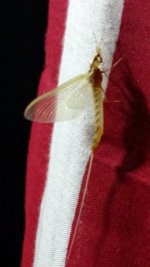strike proof
my presentation promotes trout safety
I stepped into my driveway on the night of July 4th to enjoy some fireworks out over the next hill and saw this giant, strikingly yellow mayfly clinging to our American flag. I know there is nothing in the picture for scale, but it was easily 6cm long, including the tails. I took a few pics hoping to post it here (done) and ask a few questions (doing that now).

I did some basic research and figured out that it is a Hexagenia. I have only seen a few green drakes, but to my eye, it was similar in size. The color was pretty dramatic, even at night. The tails, as you can see, are about as long as the body with antennae.
These are apparently pretty common mayflies throughout North America, but it seems like we don't talk about them very much in this area. Are they spread too thin around here for meaningful hatches? It would seem like most trout would go out of their way to chase a meal that big. Is it because they hatch in July, when the water has already warmed too much for trout fishing? I'm hoping someone can fill in the blanks for me. Also, I live a mile uphill from the nearest stream, though I do have a tiny pond across the street. Is it normal for a Hex to range this far from moving water? I didn't see any others, and I have not seen one since.
Full disclosure: I plucked it off the flag and fed it to my favorite toad, who hangs out under one of my garage lights at night.

I did some basic research and figured out that it is a Hexagenia. I have only seen a few green drakes, but to my eye, it was similar in size. The color was pretty dramatic, even at night. The tails, as you can see, are about as long as the body with antennae.
These are apparently pretty common mayflies throughout North America, but it seems like we don't talk about them very much in this area. Are they spread too thin around here for meaningful hatches? It would seem like most trout would go out of their way to chase a meal that big. Is it because they hatch in July, when the water has already warmed too much for trout fishing? I'm hoping someone can fill in the blanks for me. Also, I live a mile uphill from the nearest stream, though I do have a tiny pond across the street. Is it normal for a Hex to range this far from moving water? I didn't see any others, and I have not seen one since.
Full disclosure: I plucked it off the flag and fed it to my favorite toad, who hangs out under one of my garage lights at night.
